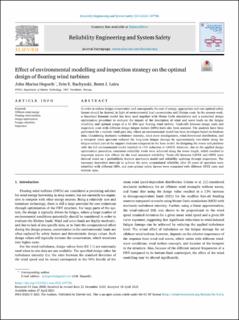| dc.contributor.author | Hegseth, John Marius | |
| dc.contributor.author | Bachynski, Erin Elizabeth | |
| dc.contributor.author | Leira, Bernt Johan | |
| dc.date.accessioned | 2021-09-10T06:58:56Z | |
| dc.date.available | 2021-09-10T06:58:56Z | |
| dc.date.created | 2021-04-29T15:57:57Z | |
| dc.date.issued | 2021 | |
| dc.identifier.issn | 0951-8320 | |
| dc.identifier.uri | https://hdl.handle.net/11250/2775097 | |
| dc.description.abstract | In order to reduce design conservatism and consequently the cost of energy, appropriate and cost-optimal safety factors should be derived, in light of environmental load uncertainties and lifetime costs. In the present work, a linearized dynamic model has been used together with Monte Carlo simulations and a numerical design optimization procedure to evaluate the impact of the description of wind and wave loads on the fatigue reliability and optimal design of a 10 MW spar floating wind turbine. Trade-offs between design costs and inspection costs with different design fatigue factors (DFFs) have also been assessed. The analyses have been performed for a realistic wind park site, where an environmental model has been developed based on hindcast data. Considering stochastic turbulence intensity, wind-wave misalignment, wind directional distribution, and a two-peak wave spectrum reduced the long-term fatigue damage by approximately two-thirds along the fatigue-critical part of the support structure compared to the base model. Re-designing the tower and platform with the full environmental model resulted in 11% reduction in CAPEX. However, due to the applied design optimization procedure, consistent reliability levels were achieved along the tower length, which resulted in important system side effects for the total structural reliability. Trade-offs between CAPEX and OPEX were derived based on a probabilistic fracture mechanics model and reliability updating through inspections. The necessary inspection intervals to achieve the same accumulated reliability after 20 years of operation were identified with different DFFs, and cost-optimal safety factors were computed with different OPEX costs and interest rates. | en_US |
| dc.language.iso | eng | en_US |
| dc.publisher | Elsevier | en_US |
| dc.rights | Navngivelse 4.0 Internasjonal | * |
| dc.rights.uri | http://creativecommons.org/licenses/by/4.0/deed.no | * |
| dc.title | Effect of environmental modelling and inspection strategy on the optimal design of floating wind turbines | en_US |
| dc.type | Peer reviewed | en_US |
| dc.type | Journal article | en_US |
| dc.description.version | publishedVersion | en_US |
| dc.source.journal | Reliability Engineering & System Safety | en_US |
| dc.identifier.doi | 10.1016/j.ress.2021.107706 | |
| dc.identifier.cristin | 1907295 | |
| cristin.ispublished | true | |
| cristin.fulltext | postprint | |
| cristin.qualitycode | 2 | |

